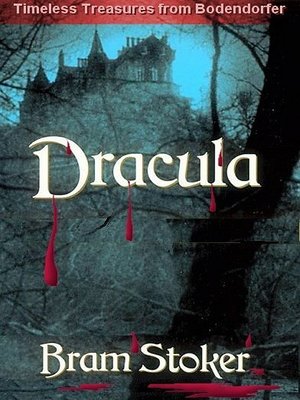
Sign up to save your library
With an OverDrive account, you can save your favorite libraries for at-a-glance information about availability. Find out more about OverDrive accounts.
Find this title in Libby, the library reading app by OverDrive.



Search for a digital library with this title
Title found at these libraries:
| Loading... |
In June of 1897, Bram Stoker's Dracula was first published. This enduring masterpiece is a novel of sexual repression and Gothic horror.
As a gothic novel, Dracula reveals a preoccupation not just with horror but also with folk legend. It is noted for its eroticism, revealing much about sexual repression and attitude towards sex in nineteenth-century Britain. The sexually provocative scenes of the three female vampires closing in seductively on a powerless but desiring Jonathan Harker tend to linger in the minds of readers.
While not received favorably by literary critics of the time, Dracula has been reprinted countless times, and has continued to sell copies for more than a hundred years. Stoker's ability to frighten and yet enthrall people has allowed the successful transformation of the novel to its numerous and varied screen adaptations. As late as May of 1897, Stoker was still using his original working title for the novel, The Un-Dead. The term "undead," was coined by Stoker and is now commonly used in horror novels and movies.
Although his novel is full of sexual subtext, Stoker's own views regarding sex and morality tended to be conservative. In fact, he favored censoring novels for their sexual content, believing that racy literature dangerously nurtured man's darker sexual tendencies. The sexual language and sensual description in Dracula tickled both the Victorian and the Christian sense of morality. Part of the novel's ruse is that Stoker manages to combine sin with sexuality in a moralizing way, thereby getting away with writing incredibly lurid and sensual scenes. The themes of Christian redemption and the triumph of purity ultimately prevail.
Dracula is an epistolary novel, meaning that is composed from letters, journal and diary entries, telegrams, and newspaper clippings. It is intended to have a vaguely journalistic feel, being a harrowing account supposedly written by the people who witnessed the book's events.
As the novel begins, Jonathan Harker, a young Englishman, travels to Transylvania on a business trip to aid Count Dracula, a Transylvanian nobleman, in buying an English estate. After a formidable journey into remote Eastern Europe, Harker is initially charmed by the Count's sophistication, generosity and intelligence. Gradually, he realizes not only that he is a prisoner in Dracula's castle, but that the Count is a demonic being who plans to prey on the populace of London. Dracula leaves Harker to die at the hands of three female vampires, but Jonathan attempts a desperate escape.
This charismatic, timeless horror classic just keeps getting better and more captivating from there.
This electronic Bodendorfer edition of Dracula includes Stoker's "How I Wrote Dracula" from the 1897 introduction, as well as a bio with fascinating information highlighting the author's relationships with Oscar Wilde, Walt Whitman, and his idolization of and life-changing relationship with famous theater actor Henry Irving. A variety of fascinating website links focusing on Stoker, Dracula, and vampires, is also included.






